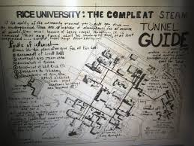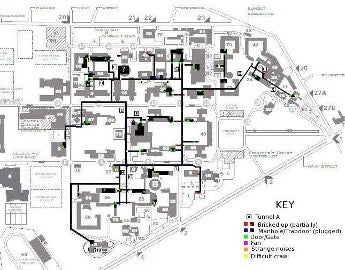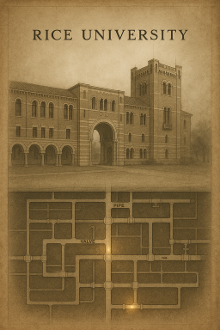Before anything else, a warning: entering the steam tunnels beneath Rice University is strictly forbidden. These tunnels are dangerous, filled with high-pressure steam lines, intense heat, electrical systems, and confined spaces. Unauthorized access is a serious violation of university policy and can lead to disciplinary action or arrest.
Beneath the orderly quads, gothic arches, and mosaic-tiled halls of Rice’s campus lies a shadow city, an invisible infrastructure running for nearly three miles. Constructed alongside the university’s founding in 1912, the steam tunnels were designed to quietly power the campus. They channel hot steam to heat buildings, route chilled water for cooling systems, and carry electrical and data conduits to dozens of academic, residential, and administrative structures. If Rice’s red brick and sandstone spires form its face, the tunnels are its arteries, hidden, essential, and quietly humming with life.

Photo from Rice University Class of 1973 FB
Despite their purely functional purpose, the tunnels have long fascinated students. Generations of Owls have passed down stories of daring (and highly discouraged) explorations into the depths. Tales vary, some speak of finding ancient machinery, others of old murals, chalk marks, or forgotten storage spaces. One persistent rumor suggests there’s a sealed sub-basement room near Lovett Hall, filled with unused 1960s science equipment and files that haven’t seen daylight in decades. There are even murmurs of ghost sightings near the Humanities Building, though these are often waved away with a smirk and a shrug.
In the late 1960s, when Rice’s student radio station (ktru) was still KOWL and broadcasting from a basement, students are said to have strung antenna wire through parts of the steam tunnels to reach across campus. The story, part fact, part fable, highlights how intertwined the tunnels are with Rice’s culture of curiosity and quiet rebellion.
Most people on campus walk right over the tunnel system daily without ever thinking about it. The Central Plant, hidden under a modest building near the Mechanical Lab, is the origin point for much of the system, which branches out like fingers to connect to Wiess, Baker, the Shepherd School, the BioScience Research Collaborative, and even parts of the graduate housing complex. Some access points are visible if you know where to look, locked gates, small hatches near loading docks, and unassuming stairwells that vanish underground. The entrances are almost always locked, and for good reasons.

Map from r/Houston (reddit)
The tunnels aren’t designed for exploration. They are narrow, some barely wide enough for a person, and sweltering hot due to the steam pipes. The air is thick, with poor visibility, and sounds are muffled into a strange, echoing quiet. University personnel who work in the tunnels do so with caution, protective gear, and a deep knowledge of what lies beneath.
However, a few have glimpsed this underworld legitimately. Rice’s Sustainability Program has occasionally offered official behind-the-scenes tours of the steam tunnels, giving small groups of students and staff a rare, sanctioned peek inside. These guided walks begin near the Mechanical Laboratory and descend into the cramped industrial arteries of campus, where insulated steam lines, chilled water pipes, and tangled electrical conduits hum with energy. Tour-goers pass submarine-style flood doors (vital in case of hurricanes) along with fluorescent lighting remnants from early energy-efficiency projects and emergency call boxes. The walls carry markings from maintenance workers, but also the echo of past intrusions: faded chalk arrows, cryptic notes, and even graffiti layered with humor and myth. One Reddit user recalled scribbles like “ABANDON ALL HOPE YE WHO ENTER” and “The owl sees all” etched deep in the tunnel's concrete skin, tiny rebellious artifacts of Rice’s unofficial history. These details, both practical and mysterious, underscore how the tunnels have become a living timeline of campus growth, patchwork engineering, and whispered lore.
Still, the mystique persists. There’s something inherently alluring about the idea of a hidden world just a few feet beneath your daily path. It’s a strange contrast, Rice with all its sunlight filtered courtyards, engineered gardens, and monumental spaces, is also home to this dark, industrial network, humming unseen beneath your feet. You’re not supposed to know or enter the tunnels. That’s part of what makes them so irresistible. But just remember, while legends and maps may circulate, and stories might be shared over late-night coffee in the commons, those stories should stay stories. The tunnels are real, and so are their dangers. Let the mystery remain a mystery and keep your adventures above ground, where they belong.
About the author:
Manuel Carmona Pichardo is from Pachuca Hidalgo, Mexico and is a current Ph.D. student in Chemistry. He got his B.S. in Chemistry at Universidad Autónoma del Estado de Hidalgo in 2016 and his MSc in Chemistry from Cologne University in Cologne Germany. Read more.
Further Reading:
The Elusive Baker Hall: What is Rice’s Premier Policy Institute & Think Tank?

